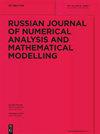固液两相混合物的正则化等温相场模型及其空间耗散离散化方程
IF 0.6
4区 数学
Q4 MATHEMATICS, APPLIED
Russian Journal of Numerical Analysis and Mathematical Modelling
Pub Date : 2021-08-01
DOI:10.1515/rnam-2021-0017
引用次数: 1
摘要
摘要本文致力于描述两相等温混合物的模型,其中一相服从固体状(即弹性)流变。考虑一个完全欧拉的描述。为了描述固相的应力-应变行为,在亥姆霍兹自由能中加入弹性能项。这一项取决于Almansi应变张量。反过来,应变张量被定义为相应演化方程的解。所考虑的模型属于相场族。形式上,它描述双组分混合物,并使用组分的质量密度作为序参数。所考虑的模型的一个显著特征是它根据准流体动力框架进行了初步正则化。在周期边界条件下,证明了总能量的耗散率。提出了一种基于交错网格的空间耗散半离散(时间连续,空间离散)方案。在没有正则化的情况下,理论结果仍然有效。本文给出了二维环境下的数值研究结果。本文章由计算机程序翻译,如有差异,请以英文原文为准。
A regularized isothermal phase-field model of two-phase solid–fluid mixture and its spatial dissipative discretization equations
Abstract The present paper is devoted to a model describing a two-phase isothermal mixture, in which one of the phases obeys solid-like (namely, elastic) rheology. A fully Eulerian description is considered. To describe the stress–strain behaviour of the solid phase the elastic energy term is added to the Helmholtz free energy. The term depends on Almansi strain tensor. In its turn, the strain tensor is defined as the solution of the corresponding evolutionary equation. Considered model belongs to the phase field family. Formally it describes two-component mixture and uses mass densities of the components as order parameters. A distinctive feature of the considered model is its preliminary regularization according to the quasi-hydrodynamic framework. The dissipativity in total energy is proved when periodic boundary conditions are imposed. A spatial dissipative semi-discrete (continuous in time and discrete in space) scheme based on staggered grids is suggested. The theoretical results remain valid in the absence of the regularization. The results of a numerical study in a 2D setting are presented.
求助全文
通过发布文献求助,成功后即可免费获取论文全文。
去求助
来源期刊
CiteScore
1.40
自引率
16.70%
发文量
31
审稿时长
>12 weeks
期刊介绍:
The Russian Journal of Numerical Analysis and Mathematical Modelling, published bimonthly, provides English translations of selected new original Russian papers on the theoretical aspects of numerical analysis and the application of mathematical methods to simulation and modelling. The editorial board, consisting of the most prominent Russian scientists in numerical analysis and mathematical modelling, selects papers on the basis of their high scientific standard, innovative approach and topical interest.
Topics:
-numerical analysis-
numerical linear algebra-
finite element methods for PDEs-
iterative methods-
Monte-Carlo methods-
mathematical modelling and numerical simulation in geophysical hydrodynamics, immunology and medicine, fluid mechanics and electrodynamics, geosciences.

 求助内容:
求助内容: 应助结果提醒方式:
应助结果提醒方式:


